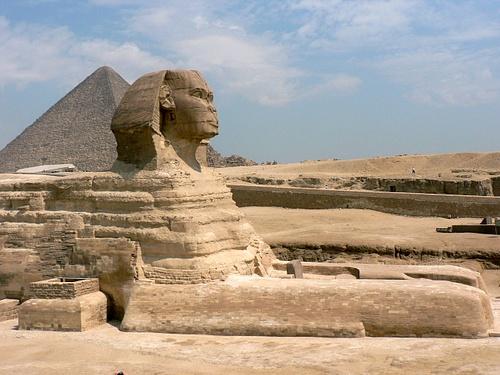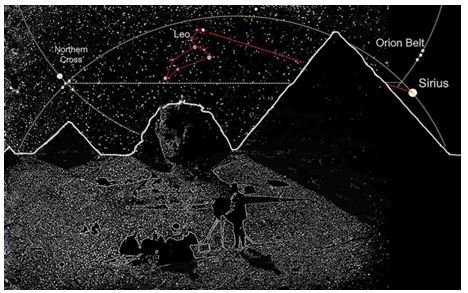The Sphinx is a colossal structure, the mystery of which still is not completely revealed. Located near the Great Pyramid in Giza, Egypt, this monument is considered as one of the most recognizable relics, whose origin, despite the number of researches, remains unclear (History.com Editors). Professor of Philosophy at Marist College, New York, Joshua claims that the contemporary world does not have the definite answer to questions: who built it, when, and why? However, the one statement about the Sphinx is indisputable, it is a significant part of ancient Egypt’s culture and represents the certain convictions of the nation that created it. This essay will examine the premises for building this monument and how it represents the value system of the Egyptians, complementing the discussion with descriptions of the Sphinx.
The ancient Egyptians were highly spiritual people, as their culture and religion were closely associated. The rationale for this phenomenon is the divine reign of pharaohs, based on the conviction that this power is the gift of gods. Therefore, the reason for building the Sphinx is cultural and religious at the same time, as these two definitions are indivisible. This monument is located in the area known as the Giza necropolis or Al Harram, which means “the Sacred Place” (Schoch and Bauval). At the same time, the Great Sphinx was originally named shesepankh, which implies “living image.” Both facts together evidence that the Giza was the “gateway” to the afterlife, while the colossal structure represented the one of the high significance in this belief, which is a spiritual guardian (History.com Editors). Therefore, the Great Sphinx played a vital role in Egyptians’ value system, as it was a sacred protector of dead souls and the remainder of the pharaohs’ reign splendor and the existence of the afterlife.
To obtain an understanding of the rationale to create the Sphinx, it is necessary to be familiar with the description of its physical characteristics and historical background. This monument is 4,500-year-old, 73 meters long, and 20 meters high (History.com. Editors). The Great Sphinx represents a creature with the body of a lion and the head of a human (the Figure 1), particularly a male with a pharaoh headdress (Barrett, 1994). According to Professor Joshua, the statue was built by the pharaoh Khufu’s order. The evidence that supports this opinion is the fact that by this period, Egyptians had enough knowledge in monument construction, which enabled them to create the Sphinx. The other evidence is that the statue is part of the king’s Khufu pyramid complex, built next to his father’s one. Mass of unutilized rock was used to carve the statue with the face of Khufu on it (Joshua). The mentioned statements imply that the reason to build the Sphinx of Giza is to honor the pharaoh Khufu, and it can be considered as cultural rationale.

The other way, in which the Great Sphinx contributes to the Egyptians’ value system is the religious one. According to Professor Joshua, “During the time of the New Kingdom of Egypt (1570-1069 BCE), the Sphinx was known by the Egyptians as Horemakhet (“Horus of the Horizon”). This statue was associated with the god of the sky by the solar cult. As Khufu was representative of Horus on Earth, his monument was honored with a temple by the pharaoh Amenhotep II, who patronized the solar cult. Later, his son, prince Thutmose had a dream that he would become the next pharaoh if he would agree to restore the Sphinx. “The deal” was accepted and completed, and after Thutmose’s reign, the solar cult grew up. This phenomenon made Egyptian society believe that the Great Sphinx is a living deity that can predict and influence the future (Joshua). Eventually, the statue, which was built to honor the Khufu, became the religious sanctuary respected by people. The mysterious image of Sphinx is the spiritual contribution to Egyptian society’s value system.
President of Research Autism LLC (FL) Antonio Cassella claims that the premises for building the Sphinx and the union of Pyramids were the intention to display all three attentions (10). Those mean an individual’s view of their daily life, inner perception of it, and the level of awareness about the world. This phenomenon also implies the existence of an imaginable circle, which determines people’s understanding about all matters and this circle can be expanded by new experience and knowledge obtaining. Ancient Egyptian civilization is known for its tendency to develop and invent, which is the result of considering the three attentions’ provisions, as they make individuals look deeper into opportunities.
The Sphinx’s symbolic head belongs to the pharaoh Khufu, which is the reference to the first attention, which considers problems of surviving, on the cognitive function basis. The Head is the part of the body, primarily responsible for thinking and deciding, and the statue’s one represents part of the mentioned circle of awareness. The creativity of the Sphinx’s leonine body is the reference to the second attention. Its function is spiritual, fulfilled through the inner action of witnessing and perceiving the events that are beyond the imagination and understanding. According to Cassella, the Sphinx and the Great Pyramid united together point directly on the Third Attention, which is the glow of awareness inside an individual (10). Therefore, the perfect composure, which includes the Great Sphinx and Pyramid, serves the purpose of symbolizing natural systems, dreams, and social progress.
Ancient Egyptian architecture was built on symbolic shape and forms basis, in accordance with the primary provisions of Astronomy. Egyptians had connected religion with this science and it affected their view. Therefore, it was a significant contribution to their value system, culture, and religion. According to Cassella, the Sphinx of Giza is part of four united structures, the monument itself, and three pyramids (3). This conglomerate is intended to repeat the move of Sirius. It is possible to notice in the Figure 2 that this star’s trajectory creates a circle around the Sphinx and the pyramids (3). From this perspective, the monument is directly under the Leo constellation. The Great Sphinx of Giza is the part of the uniting, which represents Sirius’s trajectory in the sky. Moreover, it is possible to notice the symbolism in the monument’s location, as it is located under the Leo constellation, while part of the structure is the body of a lion in stone.

The ancient Egyptians had a unique vision, the manifestations of which is a mystery for contemporary researchers. It is possible to notice that The Great Sphinx of Giza is a significant part of their value system. The rationale for the statue being created was religious and cultural monument representing both the mortal pharaoh, Khufu, and the god, Horus. Three attentions, considered in the Sphinx’s appearance and location indicate the Egyptians level of awareness and development. In addition, the appropriate place between other pyramids reveals ancient people’s substantial knowledge of astronomy. All reasons for the Great Sphinx of Giza creating show the place this statue has in the value system of Egyptians.
References
Barrett, Terry. Criticizing Art: Understanding the Contemporary. Mayfield Publishing Company, 1994.
Cassella, Antonio. “Exploring the Sphinx and the Great Pyramid Through the Logos Heuristics”. Redfame Publishing, Publications, vol. 6, no. 9, 2018, pp. 10-30.
History.com Editors. “The Sphinx.” History, 2018. Web.
Joshua, Mark J. “The Great Sphinx of Giza.” Ancient History Encyclopedia, 2016. Web.
Schoch, Robert M, and Bauval Robert. “The Great Paradox.” Origins of the Sphinx: Celestial Guardian of Pre-Pharaonic Civilization, Inner Traditions, 2017.